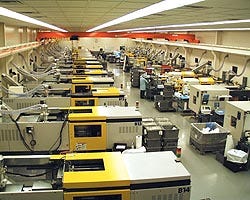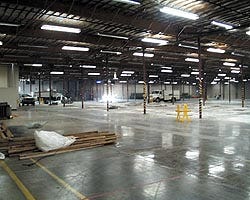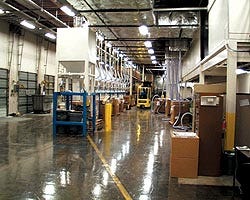Plant renovation refocuses medical molder
July 1, 2001
|
Figure 1. The new molding area is divided into three cleanrooms (shown here is cleanroom No. 2) with capacity for up to 57 molding machines. |
Safety is always a primary focus for companies manufacturing medical products, especially those producing sharp or needle product platforms. And it was this need to stay on the cutting edge of safety, with new devices for retracting or shielding needles after use, that prompted Becton Dickinson (BD), a leader in the $400 million IV catheter market, to renovate the cleanroom molding area at its Sandy, UT Device Molding facility (Figure 1 shows one of the new cleanroom molding areas). Even more impressive, the company accomplished its task—from concept to production—in just more than a year while continuing new product development and the production of more than a billion molded components. It's a move that put the company well ahead of the measures set in place by former President Clinton for the mandatory use of such safety devices for medical products by April 2001.
This accomplishment not only resulted in an impressive cleanroom molding facility, but also allowed Becton Dickinson to reevaluate its molding strategy. "We started to think about molding not so much as site specific," explains Bill Kozy, senior vp of operations, "but in terms of company-wide capacity with site-specific production. Sandy evolved as a source for molded components for the entire company, not just for that site specifically." This new strategy maximizes assets and reduces overall costs in a business that Kozy calls "asset and capital intensive."
Also important to note about the Sandy renovation is that the warehouse space used for the new cleanrooms didn't come through acquisition or new construction. Lean manufacturing practices allowed the Sandy plant simply to free up the nearly 100,000 sq ft of warehouse space used for the development (Figure 2). Avoiding the cost of brick and mortar played a large role in justifying the expansion.
In the end, the renovation and expansion included a 65,000-sq-ft cleanroom molding area and a 15,000-sq-ft cleanroom assembly operation. The final result is impressive.
|
Figure 2. BD freed up 100,000 sq ft of warehouse space using lean manufacturing practices. Construction to expand its medical device molding capabilities began in January 2000 and was completed less than a year later. |
Starting from Scratch
Scott N. England, manager for molding and extrusion operations, says there's a real advantage of "doing it all from scratch." One benefit is that it makes the facility cost per machine much lower. Although England, who has experience constructing molding plants in the appliance and business equipment industries, wouldn't reveal the exact cost per machine of the facility, he says that piecing a facility together one machine at a time makes it more costly. It also increases the number of compromises made to the layout and material flow, he says. There were few compromises necessary with the Sandy facility.
Construction on the plant technically began in January 2000 with the initial saw cutting and footing excavation. However, major construction didn't really get going until April. Still, Becton Dickinson was able to dedicate the new facility just eight months later in November (see sidebar). England cites three major factors behind the success of such a short timeline:
1. The commitment and focus from management and the construction team.
2. The use of a construction manager, Jacobsen Construction, vs. a general contractor.
3. The appointment of one of BD's engineers, Blaine Tuttle, as project engineer.
In all, the project pulled from local and corporate BD management, safety and engineering employees of the molding department, Sandy city officials, architect Eldredge & Nicholson, and several mechanical and electrical firms. Jacobsen managed the quoting, evaluated bids, made recommendations on whom to award jobs to, managed subcontractors, and coordinated with Tuttle.
Having a good construction manager and an internal project manager in place also enabled the various subcontractors to work concurrently over the project without tripping on each other, or wasting time waiting around. At one time, there were as many as 95 people from every necessary trade working in the construction area, the company reports.
Improved Efficiency
In less than a year, the build was complete. The molding area is divided into three cleanrooms and has capacity for up to 57 molding machines. Presses range from 50 to 500 tons. Currently 75 percent of the press space is used because additional molds and equipment have been moved in from other BD plants.
|
Figure 3. A materials warehouse supplies resin via overhead utilities. |
Utility channels run to the cleanrooms from above and below. All resin handling equipment is enclosed in the utility area above the molding floor between the individual molding cleanrooms. Resins are conveyed from silos or remotely located gaylords (Figure 3). Help in designing the customized material handling system came from supplier Pneumatic Conveying Inc. (Ontario, CA).
For those molds with conventional designs, runners are conveyed out of the cleanroom for regrinding in the lower utility channel, and then pneumatically conveyed to the upper level where they are mixed with virgin resin.
Adjacent to the molding area is cleanroom assembly with fully automated assembly, supplied by molding through a Kanban or "pull" system. "As a result," says England, "we can quickly adjust to changes in the demands of assembly with significantly less inventory."
Increased Complexity
Medical products with the new safety devices are two to three times more molding intensive due to increased part complexity and molding tolerances. As a result, BD molds numerous specialty components with more than 100 part numbers. Cavitation ranges from two to 64 cavities.
An onsite mold shop is used primarily for mold maintenance and repair and to build and repair core pins. The shop also supports R&D development of new products. BD's in-house R&D center uses SLA molds to produce cavities in a matter of days. "We go from design to molded parts in seven to nine days," says Kozy. "This rapid prototyping capability will be critical to launching future generations of safety devices," he adds.
|
Contact information |
You May Also Like






